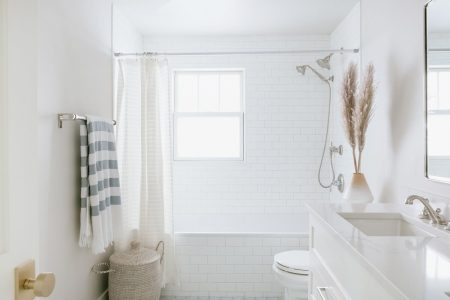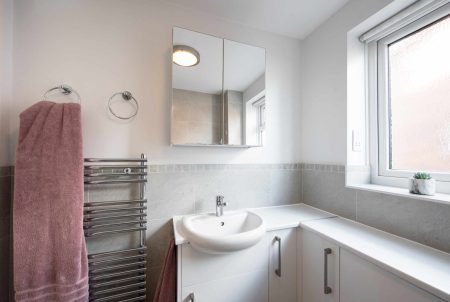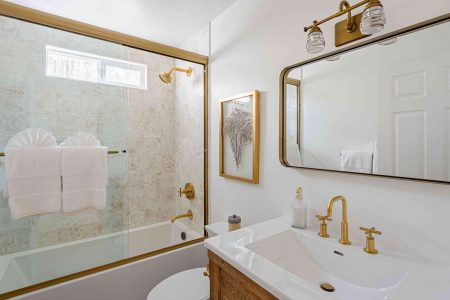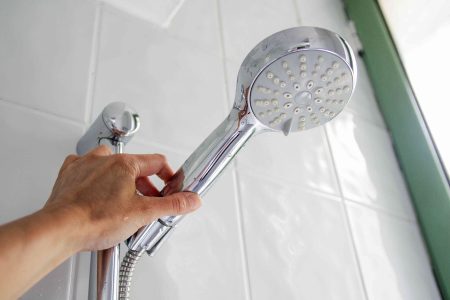Although they all serve the same purpose—to keep water in the bathtub when desired and allow the tub to be emptied again—there are several different styles of bathtub drain stoppers. The most common types of bathtub drain stoppers are lift-and-turn, push-and-pull, pop-up, toe-touch, flip-it, and trip lever.
Knowing the similarities and differences among the types is necessary when it comes time to fix your drain stopper or choose a new one. Some kinds of drain stoppers can make it rather tricky to routinely unclog the drain due to hair and debris. Below, we’ll break down the ins and outs of common styles of bathtub drain stoppers to help you identify yours.
| Types | Pros | Cons |
| Lift-and-Turn | Durable and inexpensive | Can be tricky to remove |
| Push-and-Pull | Durable and inexpensive | Can be tricky to remove |
| Toe-Touch | Easy to use without bending over | Spring will eventually wear out |
| Flip-It | Inexpensive and easy to install | O-rings will eventually wear out |
| Trip-Lever | Don’t have to reach down to the drain to adjust the stopper | Installation and upkeep can be tricky |
| Pop-Up | Don’t have to reach down to the drain to adjust the stopper | Installation and upkeep can be tricky |
Watch Now: How to Remove and Clean Different Types of Tub Drain Stoppers
-
01
of 06Lift-and-Turn
- Best for: Most bathtubs
A lift-and-turn drain stopper has a small knob on the cap, which is used to twist the stopper open and closed. It’s closed by turning the knob until it goes down, and it’s opened by lifting and turning the knob in the opposite direction.
This type of stopper is installed by screwing a center setscrew into the threaded center of the drain crossbar. The setscrew is found beneath the top cap of the stopper. Removing a lift-and-turn stopper can be a little tricky if it was overtightened when first installed or if it hasn’t been removed in some time. But overall, this is a durable, inexpensive, and simple design that rarely needs attention, other than occasionally removing the plug to rid the drain of hair and debris.
-
02
of 06Push-and-Pull
- Best for: Most bathtubs
A push-and-pull stopper is very similar to a lift-and-turn stopper in design and look, but it is pushed down to close and pulled up to open rather than twisted. Installation is also similar, with the stopper body attached to the drain with a setscrew found under the cap of the stopper.
Like the lift-and-turn stopper, this also is an inexpensive and simple mechanical design that rarely requires much in the way of repair. Over time, it will wear out based on use.
-
03
of 06Toe-Touch
- Best for: Most bathtubs
A toe-touch stopper (also called a toe-tap or foot-actuated) is closely related to the lift-and-turn and push-and-pull stoppers in look and function. This type uses a spring-loaded design, and the stopper body is held in place to the crossbar on the drain fitting via a screw underneath its cap. To close or open the stopper, you just push it down with your toe—a perk as you don’t have to bend over to manipulate the stopper.
Like the preceding stopper types, this one is inexpensive and relatively trouble-free. However, the spring mechanism eventually will wear out based on use.
-
04
of 06Flip-It
- Best for: Bathtubs without drain strainers
A flip-it tub stopper features a toggle lever attached to its top that’s moved side to side to close and open the drain. The lever moves O-rings underneath to create or release a watertight seal on the drain.
This stopper is inexpensive and easily installed with no tools. To install, you simply push it into the drain. The drain just can’t have a built-in strainer in the way. The stopper is fairly low-maintenance, though eventually the O-rings will wear out and need replacing.
Continue to 5 of 6 below. -
05
of 06Trip-Lever
- Best for: Most bathtubs
The trip-lever stopper is one of two types featuring a lever on the overflow plate at the front of the tub. For this type, there is no visible pop-up stopper in the drain opening—just a strainer. It is relatively inexpensive, though installation and maintenance can be complicated.
This stopper operates using a plunger in the tub overflow pipe, which moves up and down to close and open the tub’s drain pipe. The plunger is connected to the trip lever via a rod inside the overflow tube. When the trip lever is down, the plunger is lifted and the drain is open; when the trip lever is up, the plunger is forced down and the drain is closed. A variation does not use a lever but rather a twist cover on the overflow plate that rotates to raise and lower the plunger.
-
06
of 06Pop-Up
- Best for: Most bathtubs
The drain part of a pop-up stopper looks very much like a bathroom sink pop-up. And it is operated by the same type of lever on the overflow plate as the trip-lever stopper. When the lever moves, the connecting rod linkage in the overflow drainpipe moves to pivot a rocker arm that connects to the pop-up stopper. At the bottom end of the connecting rod is a spring that presses down against the rocker arm to operate the stopper.
Like the trip-lever stopper, this type is fairly inexpensive, though installation and maintenance can be complicated. To clean, the stopper and rocker arm must be extracted through the drain opening, and the connecting rod linkage must be extracted up through the overflow pipe and out through the overflow plate. Moreover, the complexity of the mechanism makes this stopper type susceptible to collecting hair and debris.
Choosing a Bathtub Drain Stopper
Some of the most important factors to consider when choosing a bathtub drain stopper include cost, ease of installation, and ease of maintenance. For instance, if you’re looking for a durable stopper that you can install yourself with basic plumbing skills, you might want to go with a lift-and-turn or push-and-pull model.
It’s possible to substitute one drain stopper type for another if you’re replacing an existing stopper, which can broaden your choices. For example, lift-and-turn and push-and-pull stoppers are simple to swap for one another, as their installation is similar. It’s even fairly easy to exchange a lever design for one sans lever. But it takes more substantial plumbing work to add a lever drain stopper due to the connection with the overflow pipe.
You’ll also want to consider ease of use when choosing a drain stopper. For example, some people prefer a toe-touch stopper because they can open and close it without having to bend over. Finally, you’ll have to consider what your drain can accommodate. A flip-it stopper, for instance, cannot be plugged into drains with built-in strainers.
Read the full article here














